Friday, November 10, 2006
Panther Orchard Farm - Part Three
Thursday, November 09, 2006
Faintest of traces
A boulder with a ring of stones coming out from it. Possibly one kind of enclosure or "seat":

Some kind of gate?
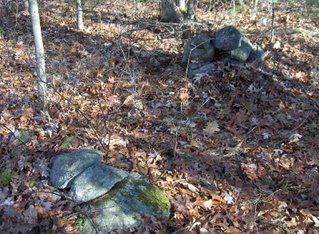 A manitou stone making up part of a small feature:
A manitou stone making up part of a small feature: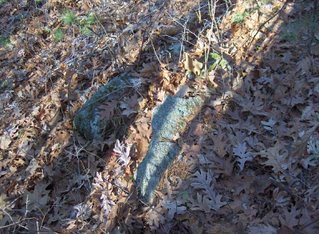 A precarious wedged rock:
A precarious wedged rock: These all were not part of a single cluster/site but were scattered along the slope at low density.
These all were not part of a single cluster/site but were scattered along the slope at low density.
Showing off some favorite piles
 Here is a detail, showing a white "window".
Here is a detail, showing a white "window". Here are some others from the same northwestern hill shoulder:
Here are some others from the same northwestern hill shoulder: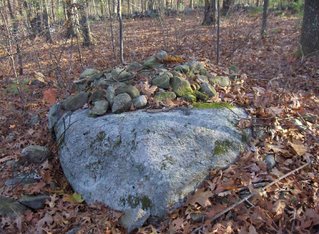

 This is part of a what I call a "marker pile site" because some of the piles are evenly spaced and in lines. On the other hand these large boulder piles are probably not in line and, although it is possible, I do not think anyone moved the boulders in order for the piles to be "just so".
This is part of a what I call a "marker pile site" because some of the piles are evenly spaced and in lines. On the other hand these large boulder piles are probably not in line and, although it is possible, I do not think anyone moved the boulders in order for the piles to be "just so".
Did I tell you about Leominster State Forest?
Quoting from the newspaper:
"Fire officials said a major hindrance is the thick growth of mountain laurel bushes, a protected species that is an attraction at the state forest. They said it is easy to become disoriented in the shrubbery, especially in last night’s steady rain and lack of moonlight. "
Based on where his car was parked (at the foot of a forest road that leads north) and based on my personal experience that you can only really travel on the roads and open trails, and based on the report that the man was "near a river", it seems pretty clear where the man ought to be: right down hill (east) from the little brookside site I reported the other day.
OK, the man found his way out. [Click here]
Tuesday, November 07, 2006
Fenton Rd, Leominster State Forest (continued)
 Here is another that caught my eye, and another by the brook that I thought was nice:
Here is another that caught my eye, and another by the brook that I thought was nice: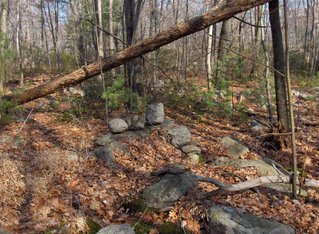
 Still more.
Still more.
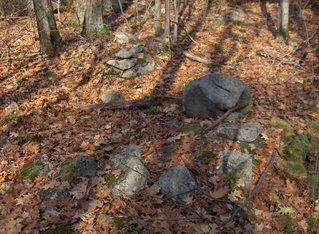 As I look at these pictures I am struck by the similarity in structure of 1st, 3rd, and 4th. They all have a curved trailing away structure made of three or four stones. Also my forced comparison with "Above the Falls" causes me to look more carefully at the relation between the two piles in that last photo. Is that a "gap" between them?
As I look at these pictures I am struck by the similarity in structure of 1st, 3rd, and 4th. They all have a curved trailing away structure made of three or four stones. Also my forced comparison with "Above the Falls" causes me to look more carefully at the relation between the two piles in that last photo. Is that a "gap" between them?
Fenton Road, Leominster State Forest
 Although much of Leominster State Forest is impenetrable because of the mountain laurel, I have often wished I could get to some of the more obscure parts. I noticed a thin trace of forest road leading north from Parmenter to the right of Rocky Pond and, because I had once noticed those little brooks descending the hill north of there and also because that little forest road leads over to at least one of the brooks, I thought it would be worth the effort to get out there, even though it amounted to a mile or so of slogging on those Leominster State Forest roads. So off I went on Sunday. That little forest road has the name "Fenton Road" and it runs just as indicated before stopping. After that you can continue on State Forest Paths and I did for less than a quarter of a mile before stopping and thinking I had gone far enough. By then the woods had opened up a bit on the right and it was possible to explore east and downhill from the path. There was a very indeterminate rock pile site there - close by an old foundation and with very little sense of sacredness or ceremony. Could they be something other than ceremonial? I was not able to decide but was not so thrilled with the discovery. Then I turned back and got off the path to explore down stream at the point that Fenton Rd crosses the brook (above the "R" at the end of "LEOMINSTER"). Sure enough there was a site there as I had hoped. Ironically I proposed an experiment long ago involving predicting where the rock piles were and then going to check. Well one of my predicted locations was exactly that brook and, I think, I just succeeded with the original experiment. Yes there were rock piles there.
Although much of Leominster State Forest is impenetrable because of the mountain laurel, I have often wished I could get to some of the more obscure parts. I noticed a thin trace of forest road leading north from Parmenter to the right of Rocky Pond and, because I had once noticed those little brooks descending the hill north of there and also because that little forest road leads over to at least one of the brooks, I thought it would be worth the effort to get out there, even though it amounted to a mile or so of slogging on those Leominster State Forest roads. So off I went on Sunday. That little forest road has the name "Fenton Road" and it runs just as indicated before stopping. After that you can continue on State Forest Paths and I did for less than a quarter of a mile before stopping and thinking I had gone far enough. By then the woods had opened up a bit on the right and it was possible to explore east and downhill from the path. There was a very indeterminate rock pile site there - close by an old foundation and with very little sense of sacredness or ceremony. Could they be something other than ceremonial? I was not able to decide but was not so thrilled with the discovery. Then I turned back and got off the path to explore down stream at the point that Fenton Rd crosses the brook (above the "R" at the end of "LEOMINSTER"). Sure enough there was a site there as I had hoped. Ironically I proposed an experiment long ago involving predicting where the rock piles were and then going to check. Well one of my predicted locations was exactly that brook and, I think, I just succeeded with the original experiment. Yes there were rock piles there.I walked all the way up Fenton till it turned to path, followed that along for several hundred yards, and then saw a kind of rough wall made of earth and rock heading downhill to the east. The woods were open enough in that direction that I got off the path to go take a look and found rock piles (approximately in the upper blue outline). They are really non-descript. No quartz, no sense of alignment, no sense of shape.

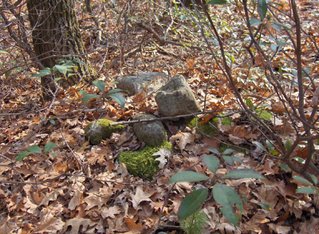 It is nice to see them in the laurels. Perhaps they are quite distinct in a shape I do not recognize.
It is nice to see them in the laurels. Perhaps they are quite distinct in a shape I do not recognize.These piles were near this structure, a historic age foundation for I don't know what.
 I poked around a bit back to the south along the same slope of hill and came on another small cluster.
I poked around a bit back to the south along the same slope of hill and came on another small cluster.
 Still not very satisfied I must believe these are Indian piles perhaps because they are small and placed on boulders. So I went back to the trail and walked back sotuhward towards the end of Fenton Road....[continued in subsequent post].
Still not very satisfied I must believe these are Indian piles perhaps because they are small and placed on boulders. So I went back to the trail and walked back sotuhward towards the end of Fenton Road....[continued in subsequent post].
The Pachaug Hoax
 The above image was sent to me several months ago by NEARA's Rhode Island State Coordinator Jim Egan. The photo was taken in the Pachaug State Forest in Voluntown, CT -- a well-known place to local folks with an interest in ancient stonework. Pachaug makes up a chain of contiguous conservation lands, as well as a relatively unbroken series of cairn sites reaching into the Arcadia and Rockville Management Areas -- two Rhode Island sites discussed extensively on this blog.
The above image was sent to me several months ago by NEARA's Rhode Island State Coordinator Jim Egan. The photo was taken in the Pachaug State Forest in Voluntown, CT -- a well-known place to local folks with an interest in ancient stonework. Pachaug makes up a chain of contiguous conservation lands, as well as a relatively unbroken series of cairn sites reaching into the Arcadia and Rockville Management Areas -- two Rhode Island sites discussed extensively on this blog.Back in 1998, a hunter stumbled upon a rock shelter site in the Pachaug State Forest. It was excavated by a team headed up by CT State Archaeologist Nicholas Bellantoni. Not much more than a few projectile points and potsherds were found. Bellantoni moved on and left any further excavations to a small team of volunteers who were trained by him.
The following Summer, the team of volunteers made remarkable discoveries. They uncovered copper beads and pieces of a clay pipe. Bellantoni ordered tests of the artifacts. A UCONN physics professor named Cynthia Peterson conducted light and heat radiation tests, determining the artifacts to be 1,000 years old.
In August of 2000, Bellantoni along with the Pequot Museum Research Director Kevin McBride returned to the site for further excavations. About 40 feet from their original excavation site they uncovered a series of amazing artifacts. But the two became increasingly suspicious. There were some problems.
Loose dirt was detected where the soil should have been compact. A tree root was unnaturally severed. A fully intact oak leaf was found at the bottom of a test pit. A snake intricately carved from copper had not properly corroded. A stone pipe appeared to have a machine-made borehole exactly 3/16 of an inch in diameter through the entire shaft. Even stranger, X-rays showed that the borehole never made it through to the bowl of the pipe, yet the bowl had tobacco residue as if it had been smoked.
After completing their investigation, Bellantoni and McBride declared the site to be a hoax. Although Bellantoni never said who he thought were the perpetrators, he did say that such hoaxes are common among people looking to either make a profit, or to support some theory.
The site sits nearby an extensive cairn field. An unsubstantiated rumor was circulated implicating, "cairn enthusiasts," as the culprits of the hoax.
[Click Here] to read the article from UCONN's Advance archives.
Monday, November 06, 2006
The Rock Pile Site Prediction Experiment
 1. Take a fragment of topo map, of someplace remote and not yet explored. [This is how I came to choose Leominster State Forest.]
1. Take a fragment of topo map, of someplace remote and not yet explored. [This is how I came to choose Leominster State Forest.]2. Circle a number of likely places on the topo map.
3. Go to those places and locate rock piles.
It turns out this is a flawed experiment. First, it turned out to be impossible to get to most of the locations I had circled - because of mountain laurel. Second it was hubris to think I could guess the conditions on the ground or the type of rock pile sites to be found at this "remote" location. Also, you need some rule about how big to make the circles and about how thoroughly to cover the available map area with circles.
So what was the result? When I first tried it, I was only able to get to two of the circles - with no rock piles in either. Each time I tried to get to one of the other circles, I had to give up but ended up finding rock piles in places I should have circled.
Knowing this, how can we improve the steps of the experiment? Well, be more systematic about circling all the likely places and pay more attention to accessibility. (Ironically, last weekend I did get to a third circle - the one second from the top right, and I did find rock piles there.) I tried to follow the modified guidelines a few weeks after the first experiment - I made a largish circle around the area near Redemption Rock (just south of Leominster State Forest), and ended up finding a number of rock pile clusters. In the end, I do not think the experiment is too successful. It is hard to be sure it evaluates site prediction when it could just be that there are lots of sites and you stumble into them regardless of what prediction/search strategy you are using. However the experiment does have one clear beneficit - it gets you looking at the topo map and gets you out exploring new territory. It does result in locating new sites.
Light Posting
Sunday, November 05, 2006
Thursday, November 02, 2006
Lost Worlds of Georgia - Video
| posted by JimP The above video is a 20-minute excerpt from a 42-minute DVD entitled "Lost Worlds Of Georgia" available for purchase at www.lostworlds.org/georgia/ Between 3:33 and 8:56 there is video and information about rock piles, stone effigy mounds, and ceremonial stone walls. The whole video is worth watching though. | |
Stories And Stones
© The Westerly Sun - Photo by MATHIAS OPPERSDORFF
Stone mason Russell Spears poses in front of his work
An article appeared in the Thursday, November 2, 2006 edition of the Wood River Press, a newspaper owned by The Westerly Sun in Rhode Island, about a documentary that was screened in West Kingston, RI Tuesday evening.
The film took six years to complete. It was filmed by Wakefield, RI resident Marc Levitt with co-producer and co-director Lilach Dekel of Transformation Films. Narragansett Tribal Council member John Brown is Executive Producer of the film.
Tribal Medicinewoman Ella Brown said, “This film could bring awareness to people not familiar with our history, our ways.”
John Brown said, “Stones are the bones, the skeleton of the earth. I have never felt a stone that was cold. They are filled with spirit.”
The documentary points out that, "becoming a mason is a choice that allows freedom of movement, freedom from inside work, from working for others and the freedom to join a long and illustrious line of ancestors."
There are no immediate plans to give the film a wider release, however several proposals are in the early stages, including one to PBS.
To read the rest of the article you will have to pay at least $5 into an online wallet, and then purchase this edition for 50 cents. [Click Here] to access the rest of the article.
Posted by JimP
Panther Orchard Farm - Part Two
The last time I posted about Panther Orchard Farm we were talking about some rock piles associated with a brook. Not far from the brook were a couple of rock-on-rocks.
Much more to come from this property!
Wednesday, November 01, 2006
One more view of the central feature above the falls
 From this angle I get a somewhat different impression of the piles beside the central boulder. They are all so parallel the one with another, with nice vertical faces all lined up. It creates a very different impression from that of "doorways" which I was promoting in the previous post. (Even if wrong the idea of a doorway is worth entertaining).
From this angle I get a somewhat different impression of the piles beside the central boulder. They are all so parallel the one with another, with nice vertical faces all lined up. It creates a very different impression from that of "doorways" which I was promoting in the previous post. (Even if wrong the idea of a doorway is worth entertaining). But whatever this is, this is a very structured and pristine site.
Above the Falls - a site at the headwaters of a brook in Bolton, MA
The rock piles are up above the falls, on more level ground up there, where water is flowing underneath the tumbled boulders in a number of places.
When I first arrived in the area I saw one nice pile and then another and another.


 As I proceeded I sensed something larger looming in the background - always a great feeling. Here is a video of my first impression:
As I proceeded I sensed something larger looming in the background - always a great feeling. Here is a video of my first impression:This large boulder is surrounded by rock piles. Here are some views of different sides and you will notice what seem like deliberate passageways between the boulder and the piles.


 I was thinking, "Gosh! Walk through there and you will come out a different person". This thought had me looking at these "passageways" as if they served a purpose as a kind of doorway with the central boulder playing an important role. Then I noticed several other examples of the same sized "doorway" but without the boulder.
I was thinking, "Gosh! Walk through there and you will come out a different person". This thought had me looking at these "passageways" as if they served a purpose as a kind of doorway with the central boulder playing an important role. Then I noticed several other examples of the same sized "doorway" but without the boulder.At around this point I realized how similar this is to what I called "pile-gap-pile" or "pile-space-pile" in describing a previously unique site in Westford. Now I know two examples of this kind of site.
Look more closely at this example:
 We look out through the gap and see a wet spot (indicated by more green in ground cover) and we also see (actually FFC noticed this in the photo) a single rock and then another further off, behind the wet spot. So perhaps it is not about a person walking through a doorway but something else passing through this space. Perhaps it is a ray of light, or something - some "energy" passing out from the wet place. This last idea is re-enforced by seeing a small pile next to the waterfall with a small gap.
We look out through the gap and see a wet spot (indicated by more green in ground cover) and we also see (actually FFC noticed this in the photo) a single rock and then another further off, behind the wet spot. So perhaps it is not about a person walking through a doorway but something else passing through this space. Perhaps it is a ray of light, or something - some "energy" passing out from the wet place. This last idea is re-enforced by seeing a small pile next to the waterfall with a small gap. Perhaps it is just damage not a deliberate gap but after looking at the larger pile-gap-piles I wonder. So what I learned is to think of these pile-gap-piles as related not necessarily to alignments but perhaps to doorways through which something could pass - perhaps something related to water not light.
Perhaps it is just damage not a deliberate gap but after looking at the larger pile-gap-piles I wonder. So what I learned is to think of these pile-gap-piles as related not necessarily to alignments but perhaps to doorways through which something could pass - perhaps something related to water not light.Here is another pile:
 This place in Bolton is west of the Rt 495/Beaver Brook corridor, in the same basic line of hills where all the other major rock pile sites are found (except for the Hill of 500 Cairns which is on the east side of the valley). All fall I have been looking for another largish site along here and am happy that with this site I also found something very distinct from the marker pile sites which are the norm in these hills.
This place in Bolton is west of the Rt 495/Beaver Brook corridor, in the same basic line of hills where all the other major rock pile sites are found (except for the Hill of 500 Cairns which is on the east side of the valley). All fall I have been looking for another largish site along here and am happy that with this site I also found something very distinct from the marker pile sites which are the norm in these hills.Nor is this site a typical "brookside" site. Absent are the numerous rock-on-rocks and alignments. There was one seat-like arrangement of three close together piles forming three sides of what could have been an enclosure. Note the piece of quartz in the pile to the rear.
 Here is a detail of it.
Here is a detail of it. Also there was at least one split-wedged rock.
Also there was at least one split-wedged rock. But this is a special kind of site.
But this is a special kind of site.Finally I should mention that near the boulder I found a large deer skull, with 9-point antlers, in perfect condition. The skull was lying teeth up, all the teeth were in place and one antler point was stuck into the ground. There was no sign of the rest of the deer and the skull was clean. Sort of curious. I traded it with FFC for a lunch.

Finnish perched boulders
If you haven't seen this already, it is worth a look. Without claiming the Finnish pre-historic cultures were related to US pre-historic cultures, it is still interesting that such things get such a different reception from the "experts" over here.


